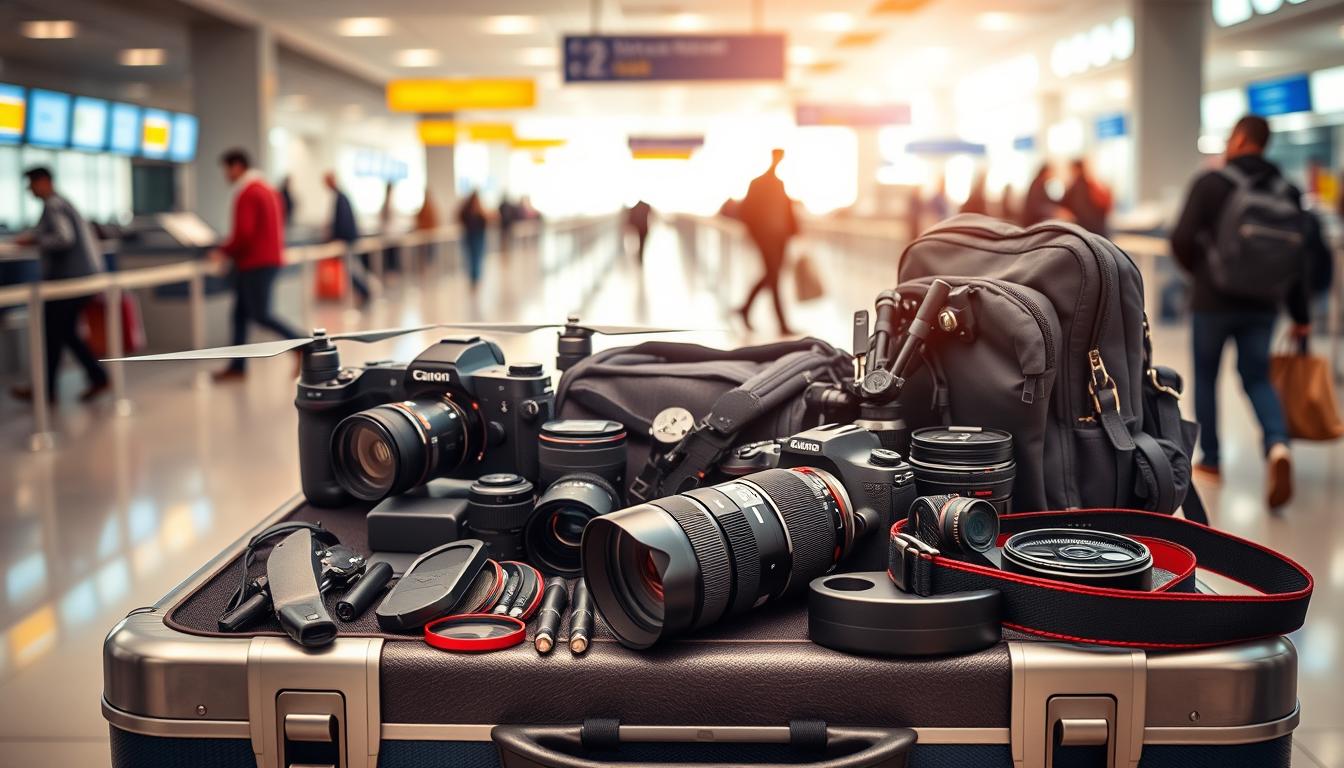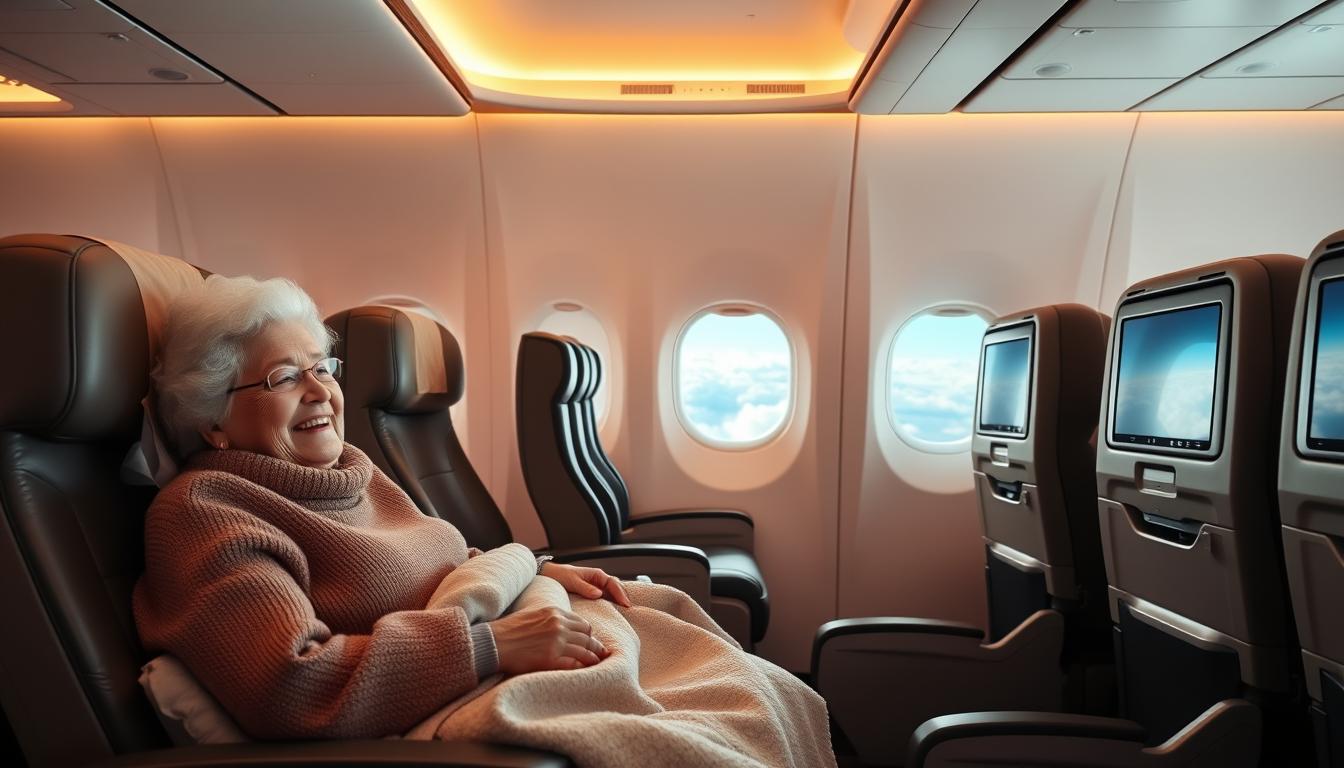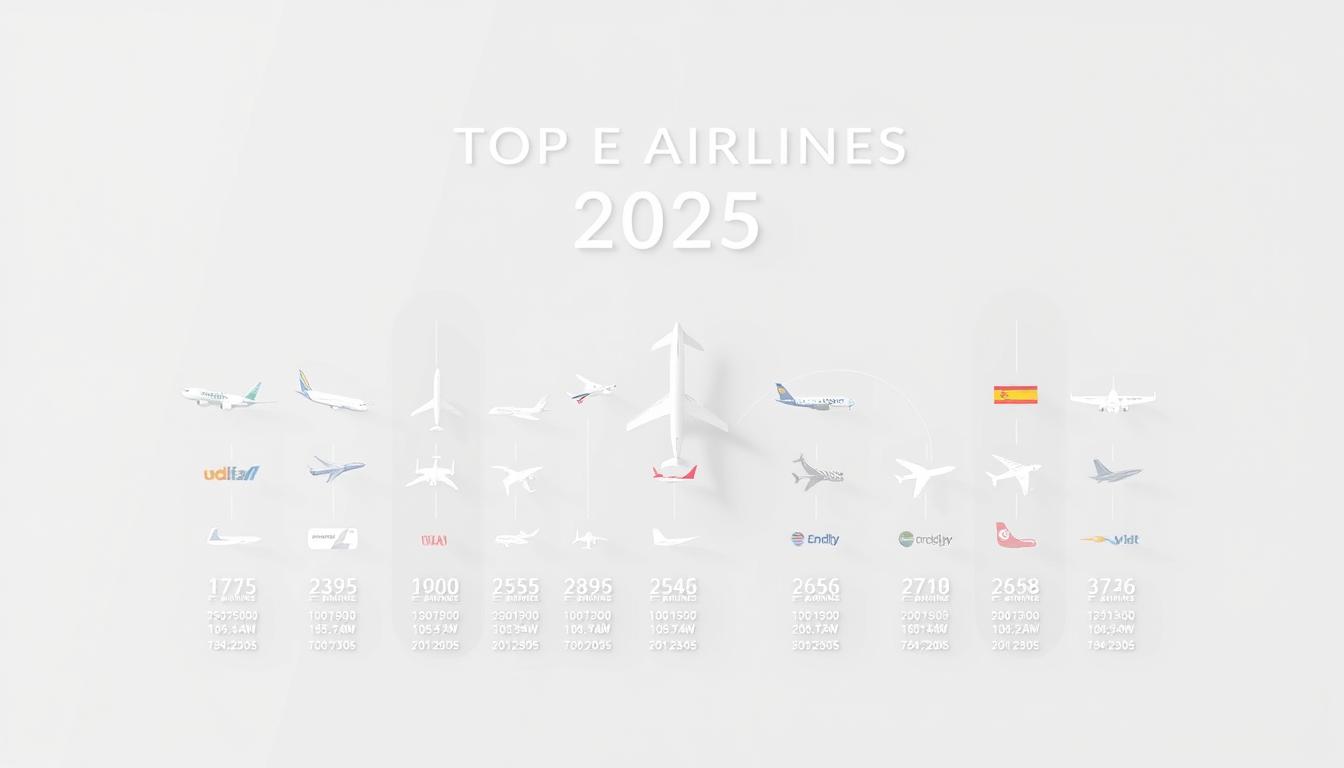Anúncios
Ever worried about your baby getting hungry in the air and not having food ready? Packing baby food for flights can be tough. You have to think about the rules and what your baby needs. Knowing how to pack baby food safely is key to a happy trip.
Understanding TSA Regulations for Baby Food
Traveling with baby food has its own set of rules. The Transportation Security Administration (TSA) lets parents carry baby food in their carry-on bags. However, these items need to be screened separately. This means parents must take out the baby food containers for inspection.
Anúncios
The TSA doesn’t have a size limit for baby food. Parents can carry big containers if they tell TSA officers at the checkpoint. It’s best to use clear containers for quicker screening. If needed, parents can ask for special handling to ensure their baby food is safe and stress-free.
What Is Considered Baby Food?
Knowing what baby food is is key for parents, especially when they travel. Baby food is made for infants and toddlers. It includes pureed fruits, veggies, and meats, meeting their nutritional needs.
There are many types of baby food out there. Commercial options come in jars, pouches, and ready-to-eat meals. These are easy to use and often have added vitamins and minerals. Making your own baby food lets you use fresh, natural ingredients and customize meals for your child.
Anúncios
When picking baby food, you can choose from different textures and flavors. It’s vital to pick foods that fit your child’s diet and age. Knowing what to pack makes traveling easier and more enjoyable. For more tips on preparing meals, check out this resource.
| Type of Baby Food | Description | Examples |
|---|---|---|
| Commercial Baby Food | Pre-packaged, convenient options available in jars or pouches. | Gerber, Beechnut, and Earth’s Best |
| Homemade Baby Food | Food prepared at home, allowing control over ingredients and freshness. | Pureed peas, sweet potatoes, and applesauce |
| Stage-Based Baby Food | Foods designed for specific developmental stages, offering varied textures. | Stage 1 (smooth purees), Stage 2 (chunkier purees), Stage 3 (advanced textures) |
Baby Food in Carry-On Luggage
Traveling with infants means knowing the rules about baby food. Parents often ask about how much food they can bring and what types are okay. Knowing what to pack helps avoid security delays and keeps babies fed during flights.
Allowed Quantities of Baby Food
Parents can bring enough baby food for the trip. This rule is made for babies’ needs. TSA says how much is okay based on the baby’s age, hunger, and diet.
Types of Baby Food You Can Bring
You can bring different kinds of baby food on the plane. This includes:
- Pouches of pureed fruits and vegetables
- Small jars of infant food
- Liquid-filled teething toys
- Homemade purees, if they’re labeled right
Putting food in easy-to-check containers helps security checks go smoothly. This makes traveling easier for everyone.
Homemade Baby Food: Tips for Traveling
When you travel with homemade baby food, being prepared is key. Good labeling and storage are crucial. This way, you can be sure your baby’s food is safe and easy to identify.
Labeling Your Homemade Baby Food
Labeling your baby’s food right is important for a smooth trip. Use clear labels with the expiration date and ingredients. This helps at airport security and keeps your baby healthy.
Storage Recommendations for Homemade Food
Choosing the right storage for homemade baby food is important. Use strong, airtight containers to avoid spills. Pick the right size to manage food and reduce waste. Also, think about keeping food at the right temperature to keep it fresh and safe.
Choosing the Right Containers
Choosing the right containers for baby food makes travel easier for parents. Transparent containers help with TSA checks because they’re easy to see through. Look for containers that are safe and work well for your trip.
Transparent Containers vs. Bags
Transparent containers are better than bags for baby food. They meet TSA rules and let you see what’s inside without trouble. This makes security checks faster and easier.
Leak-Proof Options for Baby Food
Leak-proof containers are key to avoid spills on trips. Choose high-quality plastic or silicone for the best protection. These are great for homemade food, keeping it fresh until it’s time to eat.
| Container Type | Material | Features | Best Use |
|---|---|---|---|
| Plastic Containers | BPA-Free Plastic | Lightweight, stackable | Traveling with pureed foods |
| Glass Containers | Tempered Glass | Durable, microwave-safe | Home storage and warming |
| Silicone Pouches | Food-Grade Silicone | Leak-proof, freezable | On-the-go feeding |
| Freezer-Safe Containers | Plastic or Glass | Designed for freezer use | Making and storing homemade baby food |
Preparing for Airport Security
Traveling with baby food can seem daunting, especially at airport security. To make it easier, parents should focus on TSA baby food preparation. Designate a specific area in your carry-on bag for baby food and other essentials.
This organization allows quick access during screening. It minimizes stress for both parents and TSA agents.
When you get to the security checkpoint, tell TSA agents about the baby food. This helps make the inspection smoother. Make sure all containers are easy to find and open for TSA agents.
Pack baby food in clear, resealable bags or transparent containers. This follows TSA guidelines and makes screening easier. Preparing your items in advance helps make the travel experience more efficient.
Use a checklist to make sure you have everything. You’ll need pre-made baby food pouches, snacks, and utensils. Keeping everything organized makes the TSA process smoother, making travel with infants more enjoyable.
Keeping Baby Food Safe During Travel
Traveling with baby food needs careful attention to safety and keeping it at the right temperature. This ensures it stays fresh and safe for your baby. Parents can use several strategies to keep baby food safe on trips.
Temperature Control Tips
Keeping baby food at the right temperature is key. Bacteria grow in warm conditions, so it’s important to keep food cool. Insulated bags help control temperature and prevent food from spoiling.
Staying within recommended temperature ranges is crucial. This makes sure the food is safe for your baby to eat.
Using Ice Packs and Coolers
Ice packs and coolers are great for keeping baby food at the right temperature. Products like PackIt freezable coolers keep food cold for hours. These coolers are easy to carry and work well for different travel situations.
By planning and packing these items, parents can keep baby food safe and fresh during travel.
Traveling with Formula and Breast Milk
Traveling by air can be tough, especially when you need to bring baby formula and breast milk. Knowing the TSA’s rules for these items is key for a smooth trip. Unlike other liquids, you can carry as much as you need without the 3-1-1 rule.
Being open and clear at airport security is important. Use clear bottles for formula and milk to make screening easier. Let TSA agents know you have these items in your carry-on to speed up the check.
Stay informed and ready when flying with these important items. Knowing the rules can prevent delays and worries during your trip.
Essential Packing Tips for Parents
Packing for air travel can be tough, especially when you have to pack baby food. Taking the time to prepare can make a big difference. It’s important for parents to make a detailed checklist to keep track of all the items they need.
Using high-quality, leak-proof containers helps avoid spills. This keeps baby food safe during travel. Choosing the right containers depends on the type of baby food you’re packing. Also, finding space-efficient transport solutions helps keep everything organized.
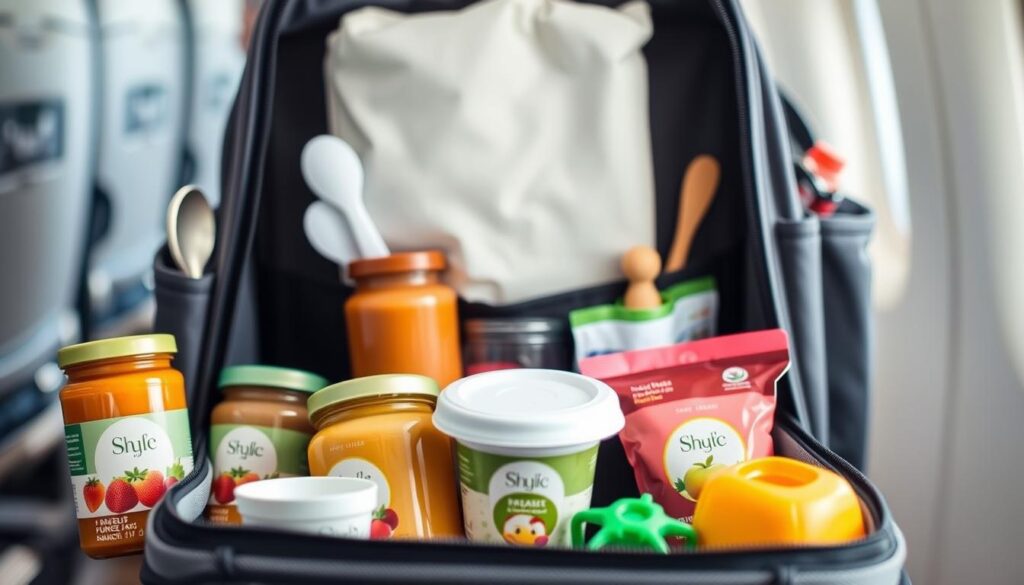
Planning a travel-friendly menu ahead of time makes packing easier. Knowing how much food to pack for the trip’s length helps avoid last-minute stress. Using meals that are easy to portion and store makes packing simpler, ensuring a smoother trip for everyone.
Exploring Freezable Cooler Options
Traveling with baby food can be tough, but the right cooler makes it easier. PackIt freezable coolers are top picks for keeping baby food fresh on trips. They have freezable gel in their walls, so you don’t need ice packs. This keeps food cold for hours.
Benefits of PackIt Freezable Coolers
Choosing PackIt freezable coolers for baby food has many perks. They have lots of room for baby items, from pureed foods to snacks. Their easy-to-clean surfaces make upkeep simple, and they come in various designs to match your style.
These coolers keep food at the right temperature without extra ice. This makes traveling with baby food convenient and worry-free.
How to Use PackIt Coolers Efficiently
To get the most out of PackIt freezable coolers, follow a few tips. Pre-freeze the cooler the night before to chill the gel walls. This step is key for keeping food fresh during your trip.
By doing this, you can store different types of baby food. It ensures food stays fresh, making travel with baby food easier and more reassuring for parents.
Meal Planning for Travel
Planning meals for baby travel can make your trip less stressful. It ensures your baby eats well while on the move. A good travel menu for infants makes packing easier and keeps your baby’s diet balanced.
Creating a Travel Menu
Think about your baby’s age and likes when planning meals. Mix fruits, veggies, grains, and proteins for a balanced diet. Choose foods that are simple to pack and serve.
Soft fruits like bananas or apples are great snacks. Oatmeal or pureed veggies are also good for meals.
Snacks and Balanced Diet Considerations
Snacks are key to keeping your baby’s energy up. Pick snacks that are healthy and easy to eat, like whole grain crackers or yogurt pouches. Balanced snacks are vital for your baby’s nutrition.
This careful planning helps your baby eat well, even when you’re not at home. It’s all about making mealtime easy and nutritious.
Handling Food in the Airplane
Proper handling of food on airplanes is key, especially for baby food. Parents must prioritize safety and cleanliness. Always check the baby food containers before opening them. If they’ve been exposed to temperature changes, keep them sealed.
Keeping your area clean after meals is important. Have napkins and wipes ready to clean up. This keeps your space tidy and prevents germs from spreading. Planning meals around your flight schedule can make the trip more comfortable for everyone.
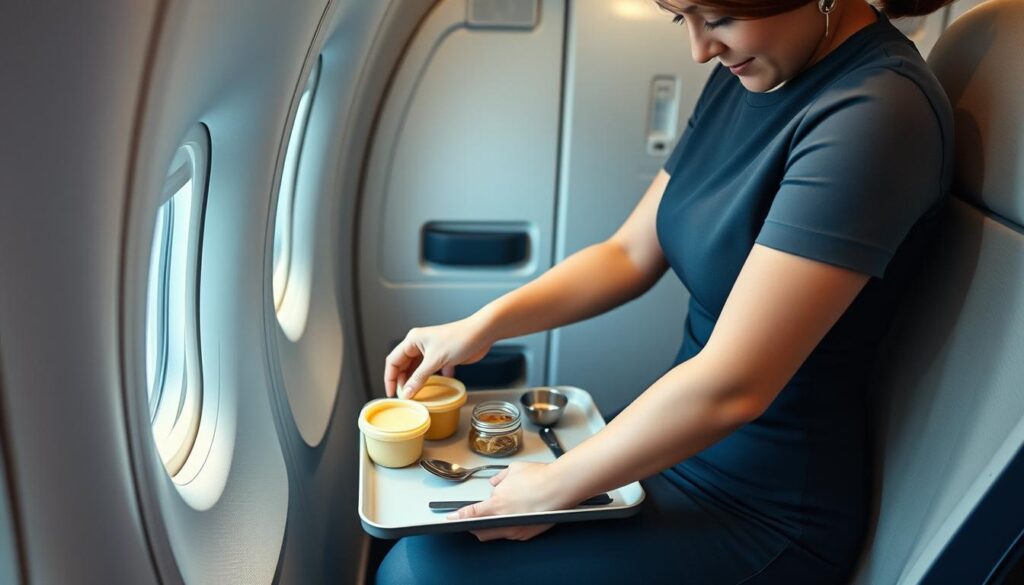
When to Use Airplane Facilities for Heating Food
Traveling with a baby often means using airplane facilities to warm food. These amenities are available, but their usefulness varies. It’s important to check their cleanliness and efficiency before using them.
Preparing food that’s okay at room temperature is a good idea. This way, you don’t have to rely too much on in-flight heating. Bringing food that’s good at different temperatures can make mealtime easier and safer for your baby.
Tips for Smooth Flying with Baby Food
Traveling with baby food can be easy and stress-free with the right planning. Begin by making a checklist of all the items you need. This way, you won’t forget anything important.
Packing food your baby is familiar with can make them feel more at ease. It also helps reduce stress for both parents and kids.
Getting your child involved in mealtime can make the trip better. Let them pick their snacks or help with simple packaging. Talking to them about what to expect can also help them feel more prepared.
Being flexible is key when traveling. Things might not always go as planned, but staying positive can help. Here are some tips for traveling with food that focus on being adaptable:
- Keep extra snacks on hand in case of flight delays or unexpected hunger.
- Be prepared to adjust to different eating schedules, especially if there are time zone changes.
- Bring enough utensils and wipes to clean up any messes efficiently.
Keeping things organized with baby food can make your travels more enjoyable. By following these tips, families can have a smooth flying experience. They’ll also ensure their little ones get the nutritious meals they need on the go.
Conclusion
Packing baby food for air travel is crucial for keeping infants and toddlers happy and fed. Knowing what baby food is allowed by TSA makes going through airport security easier. This knowledge helps make packing baby food ahead of time a key part of a smooth trip.
Choosing the right containers and keeping food at the right temperature is also important. Using leak-proof containers and ice packs helps keep baby food safe during travel. These steps are key for safe travel with baby food, giving families peace of mind.
By focusing on safety and nutrition, parents can make flying enjoyable and healthy for their kids. Thoughtful packing supports a calm journey for families. It lets them enjoy making memories together.


